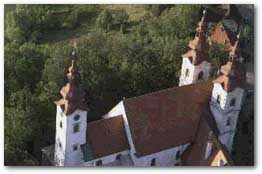![]() Maribor - Zavrh - Lenart - Sv. Trojica
Maribor - Zavrh - Lenart - Sv. Trojica
From Maribor, the road will take us through the suburs of Brezje and Dogose and further towards Zgornji Duplek, where we cross the old Drava riverbed. In Spodnji Duplek, we turn leftwards toward Zgornja Korena. Here, at the ridge peak, St. Barbara's Church, built in 1787, is Iocated. In the vicinity, there is a smaller outdoor ethnographic museum. A wondrous view of the hilly Slovenske gorice landscape is in front of us, from the point of reference in front of the Church. From Zgornja Korena, we continue passing by Zikarce to the turn for Zavrh, where we go rightwards towards the village centre. Since 1981, there has been a fine, renovated view-tower, offering a unique view of the Svecinske gorice towards central Slovenske gorice, all the way to Jeruzalem and Haloze. The Pesnica valley and Lenart are in front of us. In the direct vicinity of the view-tower, there is an inn and a countryside house, characteristic of Slovenske gorice, transformed into a museum. Rudolf Maister, the general and poet resided in the house for some time.
Let us turn back to the road turning for Spodnja Volicina and Lenart. In Spodnja Volicina, the Church of St. Rupert is located , which is mentioned for the first time in 1441. The church equipment was crafted by the Maribor sculptor Jozef Holzinger. Passing by Volicina, we go towards the main road Maribor - Gornja Radgona, where we turn left towards Lenart. The town of Lenart lies on a terrace between the creeks of Globovnica and Velka. Once, both had flooded the area, whereas in the meantime the leeds have been regulated and the agricultural land has been meliorated. The Church of St. Lenart, which lies on the main square, is mentioned as early as 1196. Though it was somewhat reconstructed later, it is today the best example of a Gothic church in Slovenske gorice. The interiors are enriched by stonecutting equipment from the nearby lime quarry and by the altar, which was made by Jozef Holzinger in the XVIII century. Lenart was destroyed during Turkish raids. As the houses were mainly of wood, it had burned down many a time as well. Thus, today's buildings - with the exception of some more significant buildiings - were mostly made in the XIX century.
 In
Lenart, we turn to the right, where we - passing the church - continue
to Sv. Trojica (The Holy Trinity). We drive along a ridge with a fine
view, where we may observe the lower Pesnica valley and the central part
of Slovenske gorice. The lakes in the lower part of the Pesnica valley
are artificial ones. They go along the Pesnica, all the way to Pernica.
They relieve the frequent hihg Pesnica water elevations. They are also
relevant for recreation, as they are known to be rich with fish. Surfing
is possible, when the wind is favourable, on the Gradisce lake, below
Sv. Trojica. At the turn-off for Sv. Trojica, we move upwards to the right,
reaching the ridge peak. In the settlement, the Holy Trinity Church, With
three bell towers,is visible from far away. Only a third of the original
church, built in the first half of the XVII century, has been maintained.
In the XVIII century, the Church was renovated in the Baroque Style, two
bell towers being added as well.
In
Lenart, we turn to the right, where we - passing the church - continue
to Sv. Trojica (The Holy Trinity). We drive along a ridge with a fine
view, where we may observe the lower Pesnica valley and the central part
of Slovenske gorice. The lakes in the lower part of the Pesnica valley
are artificial ones. They go along the Pesnica, all the way to Pernica.
They relieve the frequent hihg Pesnica water elevations. They are also
relevant for recreation, as they are known to be rich with fish. Surfing
is possible, when the wind is favourable, on the Gradisce lake, below
Sv. Trojica. At the turn-off for Sv. Trojica, we move upwards to the right,
reaching the ridge peak. In the settlement, the Holy Trinity Church, With
three bell towers,is visible from far away. Only a third of the original
church, built in the first half of the XVII century, has been maintained.
In the XVIII century, the Church was renovated in the Baroque Style, two
bell towers being added as well.

